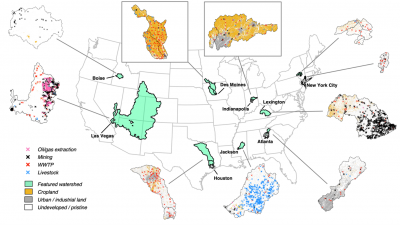Analysis of Urban Teleconnections Reveals Wide Disparities in Potential Drinking Water Contamination
Urban source watersheds are land areas where runoff is ultimately drawn into the public water supply. These watersheds may contain diverse human activities that can potentially contaminate water supplies. This potential contamination is important for water utilities and their customers, but has yet to be evaluated at a national scale. In a new study, researchers evaluate point and nonpoint sources of potential contamination for over one hundred U.S. cities. They found that potential contamination varies widely across cities.
This study provides a new means of assessing and comparing potential source water contamination at a national scale without relying on water quality sampling survey data. The analysis employs a novel approach based entirely on publicly available geospatial datasets that describe human land use, facility locations, and hydrology. The results provide the first-ever, national-scale assessment, and ranking of potential source water contamination across all large cities (population > 150,000) in the United States. These data complement existing post-treatment water quality information available to consumers by revealing both the provenance of drinking water and its interactions with potential polluting activities before it reaches the tap.
Urban drinking water supplies are exposed to contamination arising from land use and other anthropogenic activities in local and distant source watersheds. Because water quality sampling surveys are often piecemeal, regionally inconsistent, and incomplete with respect to regulated contaminants, the United States lacks a detailed comparison of potential source water contamination across all large cities. To address this gap, researchers combined high-resolution national-scale land use and facility datasets with hydrologic simulations to compute two metrics that represent potential water supply contamination from point and nonpoint sources. They evaluated these metrics for over a hundred U.S. cities, revealing enormous diversity in anthropogenic activities across watersheds with corresponding disparities in the potential contamination of drinking water supplies. Approximately five percent of large cities rely on water composed primarily of runoff from non-pristine lands (e.g., agriculture, residential, industrial), while four-fifths of all large cities that withdraw surface water are exposed to treated wastewater in their supplies.

